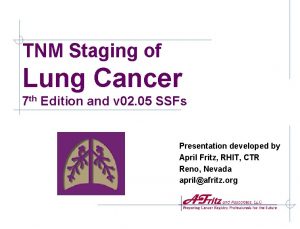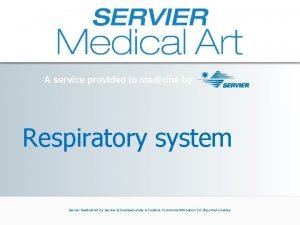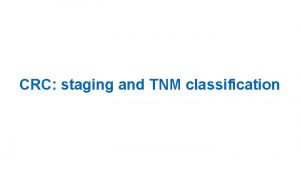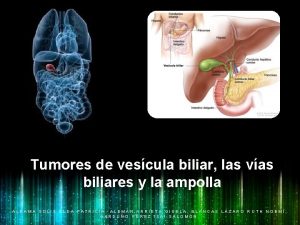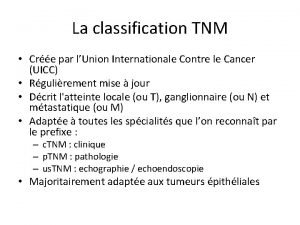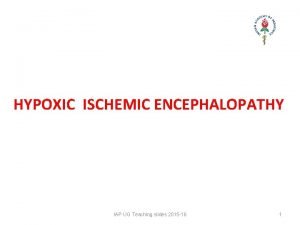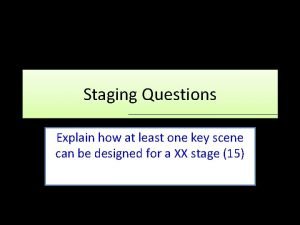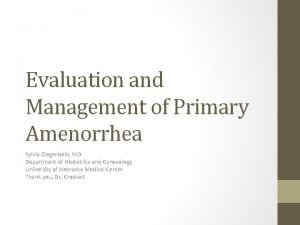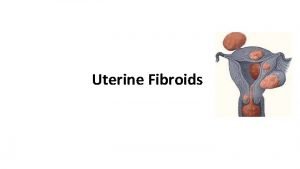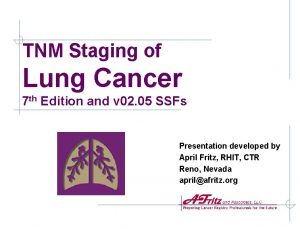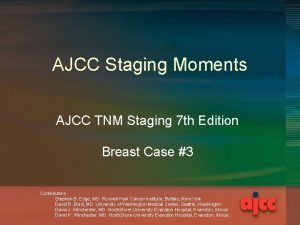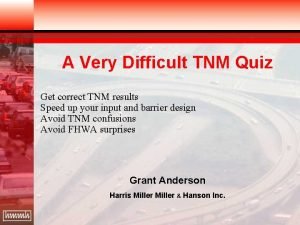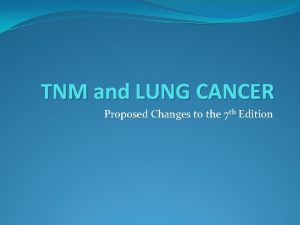TNM Staging of Lung Cancer 7 th Edition























































- Slides: 55

TNM Staging of Lung Cancer 7 th Edition and v 02. 05 SSFs Presentation developed by April Fritz, RHIT, CTR Reno, Nevada april@afritz. org

Celebrities Who Had Lung Cancer Lung Staging TNM 7 th Edition 2

The Crowded Thorax Larynx Thyroid Trachea Thymus Pleura Lungs Heart Intercostal muscles Ribs Sternum (cut away) Lung Staging TNM 7 th Edition 3 Aorta Diaphragm

Lung Anatomy showing ICD-O-3 codes Trachea C 33. 9 Carina C 34. 1 Upper lobe C 34. 1 C 34. 2 C 34. 3 Lung Staging TNM 7 th Edition 4 Middle lobe C 34. 3 Lower lobe

Important Anatomical Landmarks Apex Upper lobe Hilum Lower lobe Middle lobe Right Lung Graphics source: Mediclip, Williams and Wilkins. Lung Staging TNM 7 th Edition 5 Left Lung Lingula

Respiratory Tract Trachea Mainstem bronchus Lobar bronchus Segmental bronchus Bronchiole Alveolar duct Alveolus Adapted from R S Snell: Clinical Anatomy for Medical Students, 5 th ed. 1995. Lung Staging TNM 7 th Edition 6

Alveoli Source: http: //www. webschoolsolutions. com/patts/systems/lungs. htm#anatomy Lung Staging TNM 7 th Edition 7

The Mediastinum Clavicle Superior mediastinum Inferior mediastinum Anterior mediastinum Middle mediastinum Posterior mediastinum Image source: mywebpages. comcast. net/ wnor/thoraxlesson 3. htm Lung Staging TNM 7 th Edition 8

Bronchioloalveolar Carcinoma – New Terminology From IASLC 2011: terms BAC and mixed subtype adenocarcinoma no longer used. 1. ≤ 3 cm, NO stromal, lymphatic, vascular or pleural invasion, no necrosis, no growth patterns other than lepidic Adenocarcinoma in situ, either serous (8140/2) or mucinous (8253/2; rare) 2. ≤ 3 cm, with ≤ 5 mm area of stromal invasion or growth pattern(s) other than lepidic Minimally Invasive Adenocarcinoma (MIA): Non-mucinous 8250/2; Mucinous 8257/3 use 8253/3 until 2018 Source: 2015 WHO Classification of Tumors of the Lung Staging TNM 7 th Edition 9

Bronchioloalveolar Carcinoma – New Terminology 3. > 3 cm OR with lymphatic, vascular or pleural invasion OR necrosis OR > 5 mm area of stromal invasion OR growth pattern(s) other than lepidic Serous: invasive adenocarcinoma, lepidic predominant (8250/3) Mucinous: invasive mucinous adenocarcinoma (8253/3) Source: 2015 WHO Classification of Tumors of the Lung Staging TNM 7 th Edition 10

Invasive Adenocarcinoma n Subtypes and variants ¨ Lepidic (formerly most mixed subtype tumors with nonmucinous BAC) – 8250/3 ¨ Acinar – 8551/3 ¨ Papillary – 8260/3 ¨ Solid – 8230/3 ¨ Micropapillary added as a new histologic subtype – 8265/3 ¨ Invasive mucinous adenocarcinoma (formerly mucinous BAC) – 8253/3 ¨ Colloid – 8480/3 ¨ Fetal – 8333/3 ¨ Enteric adenocarcinoma – 8144/3 Lung Staging TNM 7 th Edition 11

Summary of Lung T Classification n TX Positive cytology only n T 1 ≤ 3 cm ¨ ¨ T 1 a ≤ 2 cm T 1 b > 2–<3 cm n T 2 Main bronchus 2 cm from carina, invades visceral pleura, partial atelectasis ¨ ¨ T 2 a > 3 cm to 5 cm T 2 b > 5 cm to 7 cm n T 3 > 7 cm; parietal pleura, chest wall, diaphragm, pericardium, mediastinal pleura, main bronchus < 2 cm from carina, total atelectasis, separate nodule(s) in same lobe n T 4 Mediastinum, heart, great vessels, carina, trachea, esophagus, vertebral body; separate tumor nodule(s) in a different ipsilateral lobe Lung Staging TNM 7 th Edition 12

T 1 Lung Cancer Tumor 3 cm or less in size, surrounded by lung or visceral pleura; no invasion more proximal than a lobar bronchus T 1 a ≤ 2 cm T 1 b > 2 to 3 cm Source: UICC TNM-interactive, Wiley-Liss, 1998 Lung Staging TNM 7 th Edition 13

T 2 Lung Cancer Tumor > 3 to 7 cm in size • T 2 a > 3 to 5 cm • T 2 b > 5 to 7 cm Any of following: • Invading visceral pleura (PL 1, PL 2) • In main bronchus ≥ 2 cm from carina • Associated with atelectasis or obstructive pneumonitis extending to hilar region but not involving entire lung Lung Staging TNM 7 th Edition 14 Source: UICC TNM-interactive, Wiley-Liss, 1998

Atelectasis/Obstructive Pneumonitis T 2 Obstructive Pneumonitis Source: www. upstate. edu/radiology/ olla/lung_cancer. htm T 3 Atelectasis of Right Lung Source: Medi-clip: Grant’s Atlas Images I, Thorax and Abdomen. Williams and Wilkins, 1998. Do not code bronchopneumonia Lung Staging TNM 7 th Edition 15

T 3 Lung Cancer (1) Any of the following: • Tumor > 7 cm Any of following: • In main bronchus < 2 cm from carina without involving carina • Atelectasis or obstructive pneumonitis of entire lung • Separate tumor nodule(s) in same lobe continued Lung Staging TNM 7 th Edition 16 Source: UICC TNM-interactive, Wiley-Liss, 1998

T 3 Lung Cancer (2) Trachea Superior sulcus Clavicle A C Any of the following: • Direct invasion of A. Chest wall B. Diaphragm C. Mediastinal pleura D. Parietal pericardium — Phrenic nerve Lung Staging TNM 7 th Edition 17 A D D Ribs B Pericardium Pleural space Diaphragm

Pancoast Tumor T 3 T 4 Pancoast tumor (superior sulcus tumor) Superior sulcus tumor with encasement of subclavian vessels or involvement of superior branches of brachial plexus above C 8 Superior sulcus Clavicle C 8 Image source: http: //www. mayoclinic. org/ brachial-plexus/details. html Lung Staging TNM 7 th Edition 18 Trachea

T 4 Lung Cancer (1) Direct invasion of any of the following: C E D B A A Mediastinum B Heart C Trachea D Great vessels Carina E Not shown: Esophagus (behind trachea) Adjacent rib Vertebral body (posterior to lung) continued Lung Staging TNM 7 th Edition 19

T 3 vs T 4 Multiple tumors in different lobe T 3 Multiple tumors in same lobe Source: UICC TNM-interactive, Wiley-Liss, 1998 Lung Staging TNM 7 th Edition 20

Great Vessels (T 4) Superior vena cava Main pulmonary artery R and L pulmonary artery trunks* R and L superior pulmonary veins* R and L inferior pulmonary veins* Superior Aorta vena cava Inferior vena cava * intrapericardial segments Heart Great vessels Lung Staging TNM 7 th Edition 21

Direct Extension per TNM Manual TNM Phrenic nerve invasion Discontinuous pleural foci Vocal cord paralysis Details coming SVC obstruction Tracheal/esophageal compression T 3 T 4* * unless primary is peripheral, then code in N Lung Staging TNM 7 th Edition 22

Summary of Lung N and M n N 1 Ipsilateral peribronchial, ipsilateral hilar n N 2 Ipsilateral mediastinal, subcarinal n N 3 Contralateral mediastinal or hilar, scalene or supraclavicular n M 1 Distant metastasis ¨ ¨ M 1 a Separate tumour nodule(s) in a contralateral lobe; pleural nodules or malignant pleural or pericardial effusion M 1 b Distant metastasis Lung Staging TNM 7 th Edition 23

Lung Cancer Lymph Nodes N 3 Lymph Nodes N 1 Same side Intrapulmonary Peribronchial Hilar By direct extension N 2 N 3 N 1 N 3 N 2 Same side Mediastinal Subcarinal N 3 Contralateral Mediastinal Hilar Any scalene Any supraclavicular Adapted from R S Snell: Clinical Anatomy for Medical Students, 5 th ed. 1995. Lung Staging TNM 7 th Edition 24

Lymph Node Stations n Not the same as N categories n Stations are based on surgical landmarks Source: UICC TNM-interactive, Wiley-Liss, 1998 Lung Staging TNM 7 th Edition 25

Lymph Nodes – N 1 and N 2 Ipsilateral bronchial Peribronchial Hilar Image source: AJCC Cancer Staging Atlas, Springer-Verlag, 2006. Lung Staging TNM 7 th Edition 26 Hilar Adenopathy Image source: www. uveitis. org/images/sarcoid 7. jpg

Lymph Nodes – N 2 Ipsilateral mediastinal Mediastinal lymph node stations Source: Workbook for Staging of Cancer, 2 nd ed. , pages 110 -111 Ipsilateral mediastinal Lung Staging TNM 7 th Edition 27 Subcarinal Image source: AJCC Cancer Staging Atlas, Springer-Verlag, 2006.

Lymph Nodes – N 3; Distant Mets – M 1 a Lymph Nodes N 3 Bilateral or contralateral mediastinal, scalene, supraclavicular M 1 a N 3 Distant Mets M 1 a Distant lymph nodes including cervical nodes Image source: AJCC Cancer Staging Atlas, Springer-Verlag, 2006. Lung Staging TNM 7 th Edition 28

M 1 Lung Cancer Pleural effusion Contralateral tumor nodule M 1 a Pleura M 1 b Pleural effusion (malignant or NOS) Pleural space Lung Staging TNM 7 th Edition 29 Separate tumor nodules in contralateral lobe Pleural nodules Malignant pleural or pericardial effusion Distant metastasis

Pleural Effusion TNM Guideline Assume to be malignant (M 1 a) UNLESS * Negative cytology on multiple exams AND * Non-bloody, not an exudate AND * Clinical judgement correlates with benign diagnosis Lung Staging TNM 7 th Edition 30

Clinical Staging Criteria: Lung n Limited to evidence acquired before treatment Physical examination ¨ Imaging studies ¨ Laboratory tests ¨ Staging procedures ¨ AJCC Cancer Staging Manual 7 th Edition, page 255 Lung Staging TNM 7 th Edition 31

Clinical Staging Criteria: Lung n Imaging studies computed and positron emission tomography) n Staging procedures ¨ Bronchoscopy or esophagoscopy with ultrasound directed biopsies (EBUS, EUS) ¨ Mediastinoscopy ¨ Mediastinotomy ¨ Thoracentesis ¨ Thoracoscopy (VATS) ¨ Exploratory thoracotomy ¨ AJCC Cancer Staging Manual 7 th Edition, page 255 Lung Staging TNM 7 th Edition 32

Pathologic Staging Criteria: Lung AJCC Cancer Staging Manual 7 th Edition, page 256 n All evidence acquired before treatment AND n Supplemented or modified by the additional evidence acquired during and after surgery, particularly from pathologic examination. Lung Staging TNM 7 th Edition 33

Pathologic Stage Provides precise data used for estimating prognosis and calculating end results ¨ p. T requires n Resection of the primary tumor sufficient to evaluate the highest p. T category OR n Biopsy that proves highest p. T category Lung Staging TNM 7 th Edition 34

Pathologic Stage Cont’d n When T is evaluated clinically, N must be c. N ¨ Unresectable lung tumor with positive biopsy of contralateral scalene LN = c. N p 4 AJCC 7 ED* n Do not record post-treatment stage n p. N ideally entails removal of a sufficient number of lymph nodes to evaluate the highest p. N category n If pathologic assessment of lymph nodes reveals negative nodes but the number of lymph node stations examined are fewer than suggested above, classify the N category as p. N 0 Lung Staging TNM 7 th Edition 35

Stage Groups Occult 0 IA IB IIA IIB IIIA IIIB IV Lung Staging TNM 7 th Edition 36 TX N 0 Tis N 0 T 1 a-b N 0 T 2 a N 0 T 1 a-b, T 2 a N 1 T 2 b N 0 T 2 b N 1 T 3 N 0 T 1 -2 N 2 T 3 N 1 -2 T 4 N 0 -1 Any T N 3 T 4 N 2 -3 Any T Any N M 0 M 0 M 0 M 0 M 1 a-b

SSF 1 – Separate Tumor Nodules/ Ipsilateral Lung n Required by COC, SEER, NPCR n Location of separate tumor nodules affects T n Codes 000 010 020 030 040 988 999 No separate nodules noted Separate nodules in ipsilat lung, same lobe Separate nodules in ipsilat lung, different lobe Separate nodules, ipsilat lung, same and different lobe Separate nodules, ipsilat lung, unknown if same or different lobe Not applicable: Information not collected Unknown if separate tumor nodules; Not documented in patient record Lung Staging TNM 7 th Edition 37

SSF 2 – Visceral Pleural Invasion/ Elastic Layer n Required by COC, SEER n For tumor < 3 cm (T 1), invasion of visceral pleura upstages T ¨ ¨ PL 1 -PL 2 T 2 PL 3 T 3 Visceral pleura (PL 1) beyond elastic layer Lung Parietal pleura (PL 3) Lung Staging TNM 7 th Edition 38 Surface of visceral pleura (PL 2) Pleural space Source: virtualmedicalcentre. com/uploads/VMC/ Disease. Images/598_Normal_L_Pleura. jpg

Visceral Pleural Invasion PL 0—Within subpleural lung parenchyma or invading superficially into pleural connective tissue beneath elastic layer. Not a T descriptor; T category should be assigned on other features. PL 1—Invades beyond elastic layer PL 2—Invades to pleural surface PL 1/PL 2 indicate VPI; T 2 descriptor PL 3—Tumor invades into any part of parietal pleura T 3 descriptor Lung Staging TNM 7 th Edition 39 Reprinted from Journal of Thoracic Oncology. Copyright © 2008 Aletta Ann Frazier, MD.

SSF 2 – Visceral Pleural Invasion/ Elastic Layer n Required by COC, SEER n Codes 000 No evidence of visceral pleural invasion; not through elastic layer (PL 0) 010 Beyond visceral elastic pleura, limited to pulmonary pleura; through elastic layer (PL 1) 020 To surface of pulmonary pleura; Extends to surface of visceral pleura (PL 2) 030 Extends to parietal pleura (PL 3) 040 Invasion of pleura, NOS 988 Not applicable: Information not collected 998 No histology of pleura 999 Unknown if visceral pleural invasion is present; Not documented in patient record Lung Staging TNM 7 th Edition 40

CODING TNM FACTOIDS Lung Staging TNM 7 th Edition 41

c. TNM – Blanks, X, or Number n Meets c classification criteria n Use x or numbers n M must be 0 or 1 n Does not meet c classification criteria T, N, and M all blank ¨ Group stage 99 ¨ Example: incidental/surprise diagnosis ¨ Chest x-ray your facility; no further information ¨ Lung Staging TNM 7 th Edition 42

p. TNM – Blanks, X, or Number n Meets p classification criteria ¨ ¨ T and N either X or numbers M 0 or M 1 n Does not meet p classification criteria ¨ ¨ ¨ T, N, and M blank Group stage 99 Example: No resection of primary Lung Staging TNM 7 th Edition 43

Source of Information? n Louanne Currance n Louanne spoke with Donna Gress to clarify when T, N, or M should be blank Lung Staging TNM 7 th Edition 44

T 4 Cont’d n Is it possible to code p. T without gross tumor removal? n What do you think? n Example (verbal) Lung Staging TNM 7 th Edition 45

Guess What – Information in Text n T 2 invasion hilar fat (unless higher by size) n T 2 a Invasion across fissure ¨ Direct invasion adjacent lobe (unless higher by size) ¨ Lung Staging TNM 7 th Edition 46

T 3 n Invasion mediastinal pleura (no matter what tumor size) n Pericardial invasion ¨ Note T 3 does not include malignant pericardial infusion n Invasion of sternum n Phrenic nerve invasion Lung Staging TNM 7 th Edition 47

T 4 n Vocal cord paralysis can be: Invasion of vocal cords T 4 OR ¨ LN involvement N 2 (find out why) ¨ n Pancoast tumor ¨ Involvement of brachial plexus ¨ Invasion vertebra or spinal canal n Direct extension to mediastinal fat Lung Staging TNM 7 th Edition 48

Must Know n Direct extension to LN coded as LN metastases ¨ Example: 2. 8 cm tumor confined to lung with invasion of intrapulmonary node – code T 1 N 1 n T based on size of tumor – N based on invasion of node Lung Staging TNM 7 th Edition 49

Requirements for p. N n First “drainage” station depends on lobe n Is one node enough for p. N? ¨ ¨ ¨ Cannot use molecular markers such as EGFR and K-ras Only sentinel node – specific circumstances Lymphoma with one clinically positive node Most chapters require 4 nodes Lung – no evidence-based studies to confirm number of nodes Lung Staging TNM 7 th Edition 50

How Many LN for p. N n Still investigational p 255 AJCC 7 ED n Evidence to support ¨ ¨ ¨ 6 or more hilar AND mediastinal nodes At least 3 nodes from N 1 category At least 3 mediastinal nodes (includes subcarinal nodes) Lung Staging TNM 7 th Edition 51

Lymph Node Stations – N Value n N 2 Ipsilateral surgical stations 1 -9 ¨ Rt lung: Stations 2, 4, 7, 10, and 11 ¨ Lt lung: Stations 5, 6, 7, 10, and 11 ¨ LL tumors should include Station 9 n N 3 ¨ Ipsilateral surgical stations 10 -14 ¨ n Stations 12 -14 lobectomy or pneumonectomy Lung Staging TNM 7 th Edition 52

M 1 a n Discontinuous tumor foci parietal pleura Ipsilateral ¨ NOT direct extension ¨ n Discontinuous tumor foci visceral pleura Ipsilateral ¨ NOT direct extension ¨ n Malignant pericardial effusion n Discontinuous tumor nodules pericardium Lung Staging TNM 7 th Edition 53

M 1 b n Discontinuous tumors chest wall ¨ Not direct extension n Discontinuous tumors diaphragm ¨ Not direct extension Lung Staging TNM 7 th Edition 54

Questions? Lung Staging TNM 7 th Edition 55
 Tnm staging lung cancer
Tnm staging lung cancer Lung lobe
Lung lobe Breast cancer staging chart
Breast cancer staging chart Ajcc breast cancer staging 8th edition poster
Ajcc breast cancer staging 8th edition poster Gulf university
Gulf university Ajcc staging breast
Ajcc staging breast Yp staging
Yp staging Carcinoma bronquioloalveolar
Carcinoma bronquioloalveolar Prostate cancer tnm classification
Prostate cancer tnm classification Sorboline
Sorboline Anatomy of throat
Anatomy of throat Prostate cancer staging
Prostate cancer staging Servier medical art
Servier medical art Lifetime risk of lung cancer
Lifetime risk of lung cancer Nursing process sequence
Nursing process sequence Lung cancer siadh
Lung cancer siadh Optimal lung cancer pathway
Optimal lung cancer pathway Gesundheit central european lung cancer patient network
Gesundheit central european lung cancer patient network Optimal lung cancer pathway
Optimal lung cancer pathway Lung cancer screening shared decision making tool
Lung cancer screening shared decision making tool Tnm ovario
Tnm ovario Crc staging
Crc staging Sirh tnm
Sirh tnm Mammadensiteit c
Mammadensiteit c Dr. manuel alejandro martínez vázquez
Dr. manuel alejandro martínez vázquez Tnm ovario
Tnm ovario Tnm colangiocarcinoma
Tnm colangiocarcinoma Tnm tiroide
Tnm tiroide Tnm 8 head and neck
Tnm 8 head and neck Tnm stomaco
Tnm stomaco Tnm yp
Tnm yp Using mis 10th edition
Using mis 10th edition Report
Report Hie grading
Hie grading Arya overweight
Arya overweight Tanner stages female
Tanner stages female Manually moving stock to staging area is an example of:
Manually moving stock to staging area is an example of: Arena stage disadvantages
Arena stage disadvantages Hepatic encephalopathy symptoms
Hepatic encephalopathy symptoms Deauville score
Deauville score Puberache
Puberache Unstagable
Unstagable What is staging
What is staging Hepatic encephalopathy staging
Hepatic encephalopathy staging Data staging component in data warehouse
Data staging component in data warehouse Perminaye
Perminaye Iap slides
Iap slides Hodgkin's lymphoma classification
Hodgkin's lymphoma classification Downstage theatre definition
Downstage theatre definition Dna original staging
Dna original staging Theatre safety rules
Theatre safety rules Epiology definition
Epiology definition Causes of primary amenorrhea
Causes of primary amenorrhea Basic dermatology curriculum
Basic dermatology curriculum Black box stage pros and cons
Black box stage pros and cons Bonney's hood operation
Bonney's hood operation

